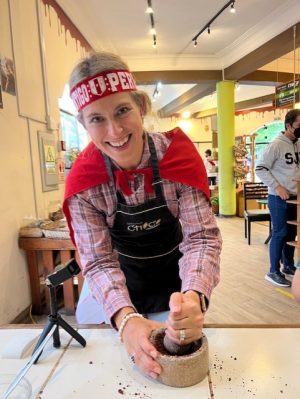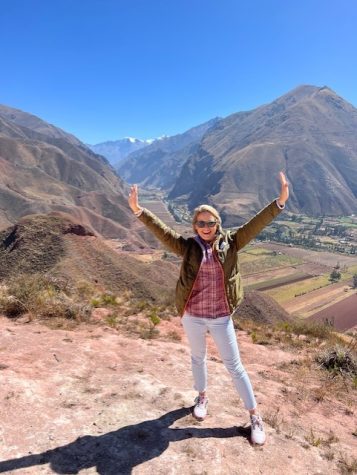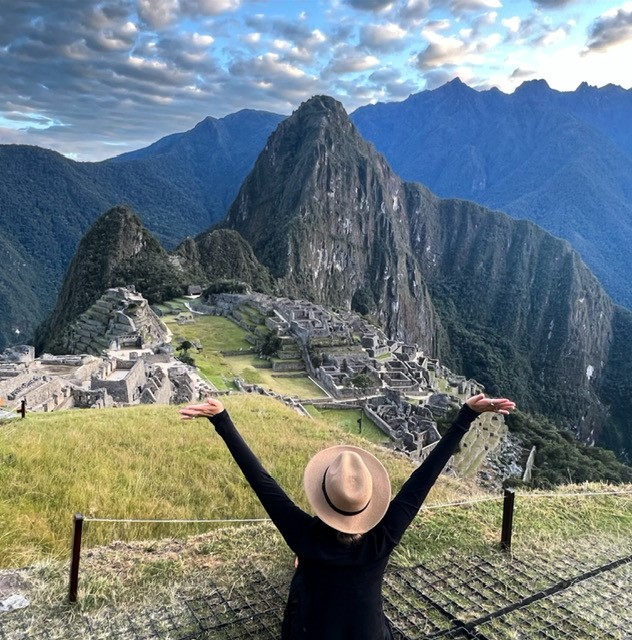Stam in Peru
Fellowship Adventures for Teachers
Stam basks in the view after hiking Machu Picchu
This summer, Spanish teacher, Adriana Stam, had the opportunity to travel to Peru thanks to the Ottenstroer Fellowship.
The fellowship, founded by the Ottenstroer family, is offered every year at Bolles on all campuses and grants five teachers an opportunity to travel, start a program, add something to the campus, and so much more.
This summer, Sra. Stam was granted the fellowship for the second time and took a trip to Peru. The first time, she applied to start the yoga program in 2017 on the San Jose campus and to get her yoga certification. Now, it is an elective available to all students and awards a PE credit to those who take it.

Credit: Adriana Stam
On June 13th of 2022, Stam took off for South America and spent 11 days in Lima, Cusco, and Machu Picchu, visiting towns like Ague Calientes and the Sacred Valley in the Andes.
“They are very beautiful in the way that they see the world. I feel like I learned so much from them and my conversations with them” — Adriana Stam
Being on a private trip meant no outside help when it came to language barriers. Most Peruvians speak both Spanish and Quechua, two languages that could not be more different.
“The Spanish was 99.9 percent the same as the Spanish that I know. There was some variety in the words.” Stam said.
However, the pre-Incan language of Quechua was completely untranslatable forStam, which allowed her to see the country both as a foreigner and a native Spanish speaker.
Among her favorite experiences of the trip was her hike up to Machu Picchu, which had the option of a two-day or four-day hike.
Because Stam was traveling alone, she recognized that the shorter hike was less risky and after completing the thrilling feat, she recommended the two-day hike to anyone who can go.
“Basically you get on a train, and it drops you off in the middle of the jungle. and there’s not even a train station where you literally jump out of the train into the jungle. It was a great mental and physical challenge” Stam said.
“I will absolutely do it again and one day I hope to bring a student group so they can see the places through their eyes.” —Adriana Stam
Along with trying “the purple corn drink”, Chicha Morada, for the first time, Stam enjoyed the humanity aspect of her trip and valued it the most.

Credit: Adriana Stam
“My favorite part was getting to know the locals and interacting with the Peruvian people. They are very beautiful in the way that they see the world. I feel like I learned so much from them and my conversations with them” Stam said.
One thing that stuck with Stam from her interactions with the people she met was the idea of the Pachamama, a word in Quechua that loosely translates to mother earth. The Quechua people make many offerings to the Pachamama and it is their reminder of taking care and giving back to the earth.
“It’s the whole idea of being connected to the universe and to mother earth. And so the word Pachamama has been something that’s stuck with me since” said Stam.
For Stam, the biggest cultural difference between Peruvians and Americans is the sense of helping neighbors and comradery.
“I feel in general, Peruvians are more focused on others than themselves, so there’s a sense of helping others. Everything they do is for others”, said Stam.
She feels as though in the US, there are similar values and we want to be in that state, but because of the hustle and bustle of everyday life, it just doesn’t happen.
“I will absolutely do it again and one day I hope to bring a student group so they can see the places through their eyes,” Stam said.



